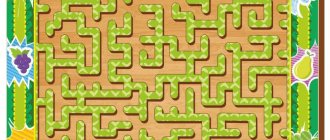Thinking is a mental process in which both hemispheres of the brain take part. Includes a person’s ability to reason, generalize, compare manifestations of reality and draw conscious conclusions from what is happening.
In order for your child to easily study at school and achieve success in adulthood, it is necessary to begin to develop thinking from a very early age.
Currently, there are many techniques and exercises that will help you, without much difficulty, during the game, develop different types of thinking in your child.
Colady magazine experts have selected for you the most interesting and effective techniques that are suitable for developing thinking in preschool children.
Development of thinking in preschoolers
Pexels Photos
You may be interested in: Why lying to children is bad, and how it can affect the child’s psyche: the opinion of a psychologist
Thinking in a preschool child is developed in different directions with the help of games, visual aids and objects.
How to develop creative thinking in a child
One of the most popular and interesting games for children to develop imaginative thinking is called “Say it in one word.” To do this, you can use both real objects (toys, household items, etc.) and pictures.
For example, ask your child to name the objects shown in the picture in one word. It can be:
- transport;
- cloth;
- animals;
- birds;
- dishes;
- toys;
- plants and much more.
Puzzles do a good job of developing imaginative thinking. To understand how to collect them, the child will first need to carefully look at the picture and highlight the important details in it. And then look for commonality in the details and image.
At first, you will need the help of an adult, but very soon your child will be able to solve puzzles on his own, and it will be possible to buy sets with a large number of parts.
How to develop logical thinking in a child
Logic in a preschool child can be developed both with the help of speech games and using visual aids.
Pexels Photos
Oral games:
- "Association". Helps develop not only thinking, but also imagination, memory and vocabulary. During the game, the adult invites the child to create a logical chain of words, and he himself names the first word. The main rule is that you cannot repeat yourself. For example, “winter - snow - frost - New Year - gifts - Christmas tree, etc.”
- " Yes or no". There can be many options for the game, both with and without the use of visual material. For example, an adult asks various questions or says statements to which the child must answer yes or no. “It’s terribly cold in summer”, “Do fish fly?”, “Our cat is green”, “Is it raining outside?” etc.
- "Let's make up a fairy tale." In this game, an adult begins a fairy tale and then invites the child to continue it. During the story, you can ask leading or clarifying questions.
Using visual materials:
- inventing fairy tales or stories based on various illustrations;
- helping a fairy-tale character navigate a maze (based on a picture or made in advance by an adult from scrap materials);
- making geometric shapes from counting sticks;
- building figures from construction sets or cubes, etc.
Logical thinking in preschool children can be developed with the help of puzzles, rebuses, riddles, dominoes and much more.
How to develop creative thinking in a child
The development of creative thinking affects the child’s imagination and ability to manage images.
Pexels Photos
To develop creative thinking, you can use the following techniques and games:
- "Unconventional drawing." Helps to fully unleash the child's creative potential. This technique uses fingers, palms, impressions, stamps, soap bubbles, salt, foam rubber and much more. There are also different methods of non-traditional drawing - dots, monotype, spray, blotography and others.
- “Take a guess.” An adult describes any object, and the child must guess it and name it.
- “Find the same signs.” The adult asks the child to find the same signs in different pictures.
- “Collect the item.” From various parts of the construction set, the child must assemble an object offered by an adult.
- "Blot". The adult invites the child to look at the blot and say who it reminds him of.
The development of creative thinking in childhood will help your child in the future find innovative solutions to even the most complex tasks and projects.
How to develop spatial thinking in a child
Developing this type of thinking will help your child navigate space better.
The following exercises are a great tool for this:
- draw a line or draw a shape on a piece of paper with your eyes closed;
- move objects further or closer, left or right;
- find the treasure according to the drawing;
- build a figure from counting sticks and others.
Photo by Pexels
In order to fully develop spatial thinking in a child, it is enough to devote 5-15 minutes a day to classes, depending on age.
How to develop critical thinking in a child
The ability to think critically will help your child cope more easily with the transition to elementary school. This skill must be developed in childhood, since it is much more difficult for an adult to develop it fully.
One of the best ways to develop the ability to think critically is to ask your child detailed questions that do not require only a “yes” or “no” answer.
This can be done in different ways. For example, watch a cartoon with your child. Some time after the start of viewing, press pause and invite him to tell his version of the development of the further plot. You can help with guiding or clarifying questions. Then watch the film and together discuss the real ending of the story and the child’s version.
Discuss your prohibitions with your child and invite him to independently determine why he should not do something. For example, “Why do you think I don’t let you walk through the puddles?”
When developing thinking in preschool children, it is important to remember that this needs to be done in different directions. It is impossible to raise a full-fledged personality if, for example, you engage only in logical or creative thinking.
When choosing games and exercises, be sure to take into account the age and character traits of your child. For the youngest children, classes should last no more than 5 minutes, and by 6-7 years old they can be extended to half an hour.
Expert comments
Parenting tip #3
There is an excellent addition to logic educational games. This is attracting a child to more adult activities (crosswords, Sudoku, checkers, chess, backgammon, puzzles, tests). Gambling (card) games are useful for developing the ability to analyze and find a non-standard way out of a situation, but are not recommended for children aged eight years.
Chess is a logical game for children from 6 years old
Give preference:
- making sentences from words;
- introducing missing words;
- finding differences.
The above tasks are also used for adults - in IQ tests.
leave a comment
What educational games to play with your child - said Ekaterina Patrina, teacher
Some of the games suggested above will require more time and attention from parents, while some other games can be done without any dedicated time. In any case, parents must understand that all this is an invaluable contribution to the child’s life and to his future. For example, the game “Associations” can be played on the way to kindergarten, school, or just while walking.
Among the proposed games, all are important and they all need to be given the same amount of time in order to grow a full-fledged personality. However, based on my experience working with students and adults, I would recommend that parents pay special attention to games that develop critical thinking. If you do not develop it in childhood, it will be even more difficult to develop it in adulthood.
In English classes, I often have to work with people who have a higher education, a prestigious job, a family, and a range of interests. But in almost every lesson they have difficulty answering a question in detail, often making do with short “yes” and “no,” although the topics for discussion can be very simple: movies, travel, work, friends. It is impossible to learn to speak a foreign language without detailed answers, which is why in my classes I often teach students to think critically, although all this can be learned much more easily in childhood.
conclusions
Preschool childhood is a period in a person’s life during which he acquires basic knowledge, skills and abilities, and his personality and intellect are formed. Among the most important mental new formations is thinking. It is with its help that the child gets to know himself and the world around him. Children of early age are characterized by a visual-effective type of thinking; in early preschool age, a visual-figurative type is formed, and in older preschool age, a verbal-logical type of thinking is revealed to the child (although figurative thinking remains the leading one). The development of a child’s thinking depends on experience, so it is very important to provide the child with the opportunity to see the world as widely as possible, as well as to train his thinking abilities. Thinking development activities can be interesting and exciting if done in a playful way. Choose exercises that you also like, because when both an adult and a child enjoy the process, the result will be much better.
How to develop preschool children - said Maya Makieva, child psychotherapist
Preschool children actively explore the world and therefore have great curiosity about everything that happens around them. They greedily absorb all the information that adults offer them, as they dream of growing up quickly, becoming smart and strong. Therefore, it is simply impossible to overestimate the role of parents in shaping the child’s thinking.
Games are of great importance in a child's life. It is during play that the most rapid and high-quality development of the child’s imagination occurs, the active work of all thought processes and the assimilation of new information, since the child wants to learn and do something new through play. It is through the game that parents have the opportunity to convey important information to the child, form the values and rules of life for their child, since in the game the child is ready to listen and hear you.
This article presents excellent options for short-term games that will allow you to develop all types of thinking, diversify your communication with your child, as well as spend time with him with benefit and interest. But remember that these games must be strictly dosed, and if you see that the child is starting to get tired, end the game on time.
Mental operations
Observing how a child’s thinking develops, the entire thought process can be divided into stages:
- comparison;
- analysis;
- synthesis;
- generalization.
At the comparison stage, the child learns to find the same in different things, different in the same. During this period, it is appropriate to give “find the differences” pictures and play memory games (start with 6 pairs of pictures, gradually increasing the number).
At the analysis stage, features, qualities, properties, materials and objects used are identified. In his imagination, a child can divide any product into its component parts.
The synthesis stage is closely related to the analysis stage. Without analysis it will not be possible to synthesize. An example of this is reading. Without remembering letters, without understanding how they merge into syllables, a child will not be able to read.
Vivid signs of generalization are the identification of common characteristics of objects and grouping. As soon as a child develops coherent speech and the use of a large number of generalizing concepts, you know that the generalization stage has begun.
Why develop on your own if there is a school?
School programs develop thinking, but working with your child at home is no less important. And here’s why: lessons at school give children new knowledge, but it’s homework that helps them consolidate and assimilate it—it’s the same story with exercises to develop thinking.
In addition, at home the child feels more comfortable - with his family it is easier for him to share thoughts, make mistakes and try again. Here are some more reasons in favor of developing your thinking:
- Antistress. With developed thinking, it is easier to cope with emotions and solve difficult situations.
- Save time. Children with developed thinking know how to set priorities and strive to manage their time themselves.
- Creativity. Non-standard ideas and new solutions are in demand both at school and beyond. Developed thinking helps to see where the border of stereotypes and norms lies - and when it is appropriate to go beyond them.
- Social implementation. Underdeveloped thinking limits potential. To become a physicist, in addition to good grades at school, you also need diligence and motivation to enter a university and complete your studies. It’s the same with work - specialists with flexible minds have more opportunities compared to those who only have knowledge and experience, but do not have the necessary skills.








